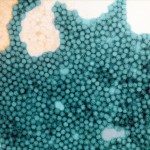Link to Pubmed [PMID] – 15820151
Microbes Infect. 2005 Apr;7(4):767-75
Post-transcriptional gene silencing (PTGS) makes possible new approaches for studying the various steps of the viral cycle. Plus-strand RNA viruses appear to be attractive targets for small interfering RNAs (siRNAs), as their genome functions as both mRNA and replication template. PTGS creates an alternative to classic reverse genetics for viruses with either negative-strand or double-stranded RNA genomes and for those with a large genome. PTGS allows modification of the expression of a given cellular gene as a means to elucidate its role in the viral cycle and in virus-host cell interactions, and to investigate cellular pathways involved in viral pathogenesis. It also allows the creation of new animal models of human diseases. In addition, PTGS already appears to be a promising new therapeutic tool to fight viral multiplication and dissemination through the host and to prevent inflammation and virus-induced pathogenesis, including virus-induced tumorigenesis.


